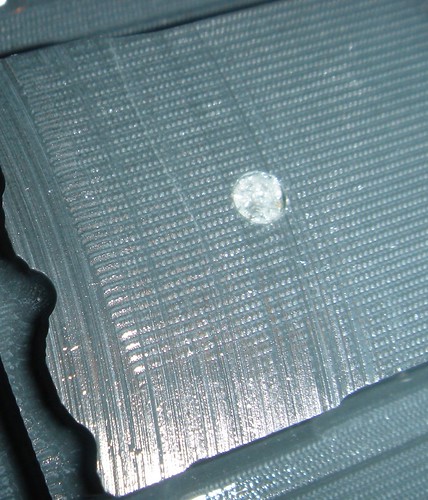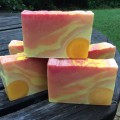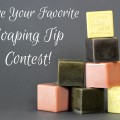 When we purchased the Heavy Duty Mold line back in June, we planned on expanding the already cool mold line. There are so many nifty mold ideas floating around my head and I’ve heard some incredible design thoughts from soapers over the years. Having the freedom to design new molds has long been a dream. With the purchase of the Heavy Duty Mold line, that dream is a reality. And like many dreams that turn into reality, the reality is a little um, hazier than it appeared to be at first glance.
When we purchased the Heavy Duty Mold line back in June, we planned on expanding the already cool mold line. There are so many nifty mold ideas floating around my head and I’ve heard some incredible design thoughts from soapers over the years. Having the freedom to design new molds has long been a dream. With the purchase of the Heavy Duty Mold line, that dream is a reality. And like many dreams that turn into reality, the reality is a little um, hazier than it appeared to be at first glance.
We have a large warehouse for ELF Industrial (the name of the company set up to design, produce and manufacture the Heavy Duty Line and new molds). In this warehouse we have a vacuum forming machine and the backstock of Heavy Duty Molds. We also have a complicated, beautiful machine that is run by a heavy duty computer program. The ‘beautiful machine‘ then cuts designs to the computer’s specifications.
We have been working on various custom design project for a couple months. The designs are done. The dies are cut. And we’ve produced molds with the dies. So far, so good.
Alas, the molds have striations – fine tiny lines running down the entire width. We’ve tried sanding them away and still, the sanding isn’t totally invisible to the naked eye when a mold is made. These fine lines are called ‘tooling marks‘ and apparently, everyone gets them. While I will admit to some irritated rumination (‘Why didn’t anyone tell me this before now? Did the expensive beautiful machine people not mention this on purpose?‘), mostly I’ve been hard at work trying to find an alternative solution to the mostly-not-totally-working sanding option.l
I’ve called a chocolate molding company. They get them and say the only thing to do is sand them. Erik (manager of Otion and ELF) has called the materials supplier and they say to sand them. I called a chemical company. They said to sand them. But, they also suggested a low pH solution to try and buff out the lines with a chemical bath.
I tried a solution with a pH of 3. That didn’t make a dent. Today, I’m trying a variety of chemical concotions that have proven to alter Polyurethane. The dies are made out of a very high density Polyurethane and thus far, seem impervious to everything.
I’m coming to you because with all of your different industries and backgrounds you will have ideas. If you have a winning suggestion that works to smooth the striations, I will send you a set of the brand new, not yet released molds, as we perfect them. That’s 12 molds in all. Or, if you’re not into molds, I’ll give you a gift certificate to Bramble Berry for $50. You can post ideas here or if you want yours to stay super secret, email me at info (at) brambleberry (dot) com. You can also feel warm and cheery inside knowing that you’ve saved me countless hours of teeth gnashing, phone calls, chemical engineering consulting and helped further the innovative soap mold industry.
Got any ideas? Email or post ’em. I’m confident the soaping community can solve this small chemical engineering mystery.







Okay, more updates:
We reset the tool paths. That helped a good amount.
We are trying a mini sand blaster today and have seriously hopeful hopes about that. =)
Ok, here's one I haven't heard yet.
My local knife sharpener sells a polishing paste that's like toothpaste with a grit. you just squeeze some on your surface, then polish with a paper towel or cloth. It gets rust off of metal. Maybe it would work with either your original mold, or the 3-d object you make with your original mold so you can polish that and make a better mold.
And good luck! -Amanda
Okay, so updating:
Heat totally melted everything – there was no in between point with a gloss.
The new fine grade sanding paper got here today.
I'm using softer dies now to try acetone on just to see.
We're adjusting the bit speed pass to be slower.
Diane's idea of making one perfect mold and then using that to make a negative and produce 4 good steel dies is a good one. We have material on the way to try that as well. I also haven't tried a flame. I should try that …
Diane, Tell your hubby 'Thanks!' =)
I showed your pictures to my husband who is kind of a geek and very mechanical. He used Klingspor abrasive products in a company he owned in the 90's. They work well but may not be useful in producing a mold which remains faithful to the original design.
He says that based on what he sees in the picture, it looks as if you are using a CNC type machining process or a rapid prototyping machine to produce your molds. He thought that (if it is possible with the equipment you have) programming your machinery to make runs in an east- west direction and then re machining the same mold face in the opposite direction. This would reduce your striations to a series of dots at intersections of the runs. They would be easier to remove and if the working area of the cutting tool was small enough they be un-noticable.
Failing that, he suggested forming the mold, producing a finished article and then after making correction to the finished part, using it to produce a mold using a more conventional method.
One more idea: PolyUrethane is a very inert material and resistant to most chemical products. That is why chemical containers are made out of it. He suggested that heat can make these adjustments. A quickly applied heat pass (yellow flame) over the surface would affect the striations first, and tend to level them. This would have to be perfected through trial and error. "Polishing" could be accomplished in this way.
Finally, my husband said to let you know that he thinks your whole business model is very cool and wishes you lots of success.
You might try talking to your PET bottle vendors. The large manufacturers have ventures that make their own molds, highly complex, but perfectly polished. They might share some techiques that you can use.
my suggestions are to try Media blasting
or a
die grinder with a real fine stone
they use that on air planes and making cars
Dear Anne-Marie,
I know other mold makers use other materials but perhaps they know the best solution to this problem. Denise from Mold Market, Catherine from Milky Way Molds and Armond from Chase Holding would be the first people I'd ask for insider advice. I NEVER think of soap makers or mold makers as competitors, each person/vendor brings something totally unique to the table and the better their work is (at what they do best), the better I am inspired to be (at what I do best).
Hi Linda –
Found a mini sand blaster here: http://www.vaniman.com/mobile-problast-80017.php for $350 so that might be another route if all my fun ideas that I have right now don't work. $350 is a lot of money but to save thousands of hours of sanding, it might be worth it. =)
Have you tried a light sand blast with a very gentle grit – something like ground walnut shells? It might be worth a try.
Sand it down, start with rough sand paper (as rough as you need to get rid of the striations) and use finer and finer grit each time to get rid of the sand paper scratches. And he recommends polishing with emery cloth as a final step.
and i have had bad bad luck with
heat guns…
what about an elastomeric polymer coating like you put on commercial roofing?
My husband uses…(looking in trade manuals)….sorry i can't find right now..
well i can't find them but here is a link:
http://www.epdmcoatings.com/liquid_rubber.html
a liquid rubber.
H – Love that idea. Turtle wax or something like it seems like a good idea for the flat ones with very little detailing. I'll try that.
Gail – Wonderful idea. I'll contact Micro Finish USA. Had never heard of them. If it's not too much money, it would save serious time because all of the sanding isn't time effective AND it's not really working either.
Karin – Never heard of a etching primer. I'm all over that via google right now. Thought about sand blasting and it would have to be a super teensy mini sandblaster to work because of the details but yes, ostensibly, that would work.
✄ ✂ ✄ ✂ ✄ ✂ – Heat is a great idea. A heat gun won't work since the plastic won't melt under 400 degrees BUT I did find a fiberglass testing oven in town that has agreed to let me try a heat test today. I'll keep you posted.
Justine – Acetone. Love that idea. According to the Polyerethane Chemical Resistance Chart, the Polyurethane should be wildly reactive with that. And, it's an OTC thing so not toxic to my staff. On it today …
Alex – Thanks for Klingspor. Had not heard of them and am psyched to find they have finer grade sandpaper products than our local stores do. 1200 Grit? That would totally get rid of the little lines we have! (rejoicing)
La Cubanita – We've tried the varnish thing and the varnish (8 coats of it!) filled in the lines really well but you can still see the lines. It was definitely better than nothing but not perfect. I'm open to try a different type of varnish.
Tincan – Lye is definitely on my list to try. I brought it home last night to do but didn't want to leave it on my kitchen counter, unattended, in case there was a reaction that needed human intervention.
You guys are SO awesome. I knew if I brought this issue to you that you would have something … I'll try everything and keep you posted.
I am not a chemist – but I make CP Soap and use lye alot – It's extremely caustic and they always tell you not to mix your lye with or in anything but heavy duty steel or tempered glass. So I was thinking that maybe you could make an extra strong solution of lye and water and dunk the mould in that and let it sit for a few days????
I was also going to mention using heat of some sort. If that doesnt work have you tried maybe coating the molds with some sort of clear coat of something to smooth it over?
Sanding master molds is just part of the process. If you're using a CAD tooling setup, you'll always have sanding to do. Just part of how it all comes together. Luckily, you only have to do it for the master mold. Then you can make secondary working molds or multiple masters in latex which wont need retooling.
good luck! If you need help finding the perfect sanding tools and abrasives, check out Klingspoor. Awesome stuff.
Is it possible to make the mold in reverse so that the striations are on the back of the mold? Sort of like an embossed type of design… I think, lol.
I would also vote for heat but not a heat gun. Maybe a warm to hot waterbth and than some kind of buffing.
One other idea. I don'T know if artifical nails are made from the same stuff but to buff out lines you use some acetone, this might work also.
Have you tried using heat? Maybe from something as benign as a heat gun or something a little more hardcore, like a propane or acetylene torch?
I sent you an email- nothing super-secret :), just too much to put here…
Chemical etching. You can get a polyurethane etching primer (actually a stuff from a place that does lining of tanks or even the spray on pick up bed linings) and that may smooth it out. I don't remember any of the process anymore other than a starting wash of MEK, then no idea what all was in the etching solution. If we could get years worth of corrosion out of the inside of a tank, it may work. Or find someone that can do sandblasting. Those are suggesions to fix these anyway.
Maybe try contacting these people?
http://www.microfinishusa.com/services/moldpolish.asp
What about sort of filling the marks with something. Like maybe Turtle wax or some other sort of softish wax? Sometimes if there's a crack in my soap, I warm a little speck of soap in my hand and fill it. Then buff with my fingers. I don't know if that even makes sense. Kind of like spackle?